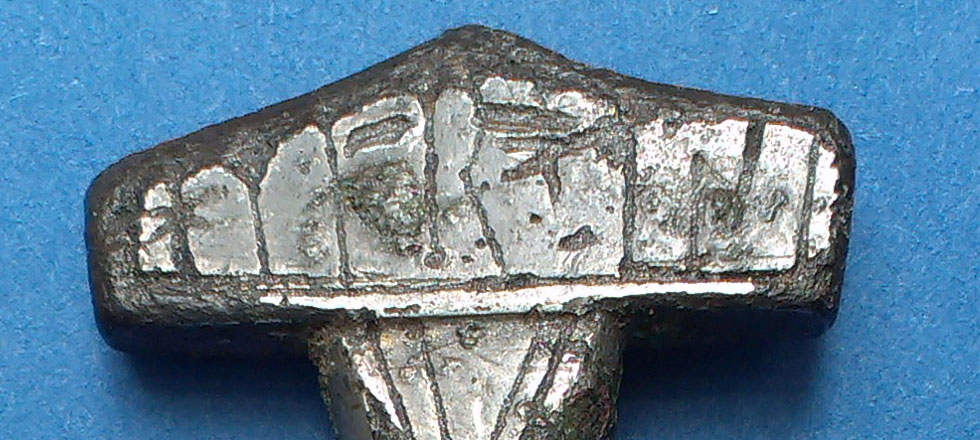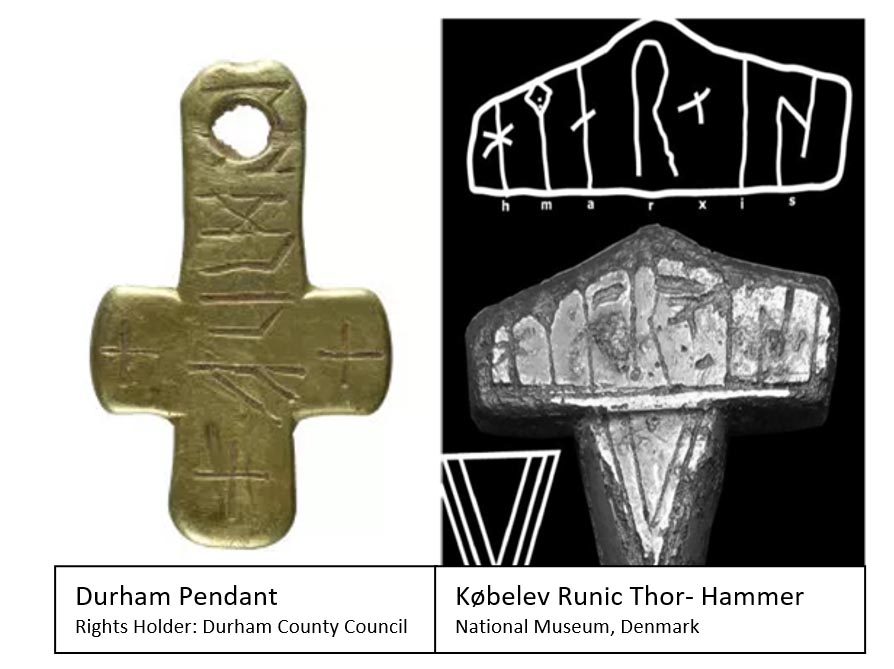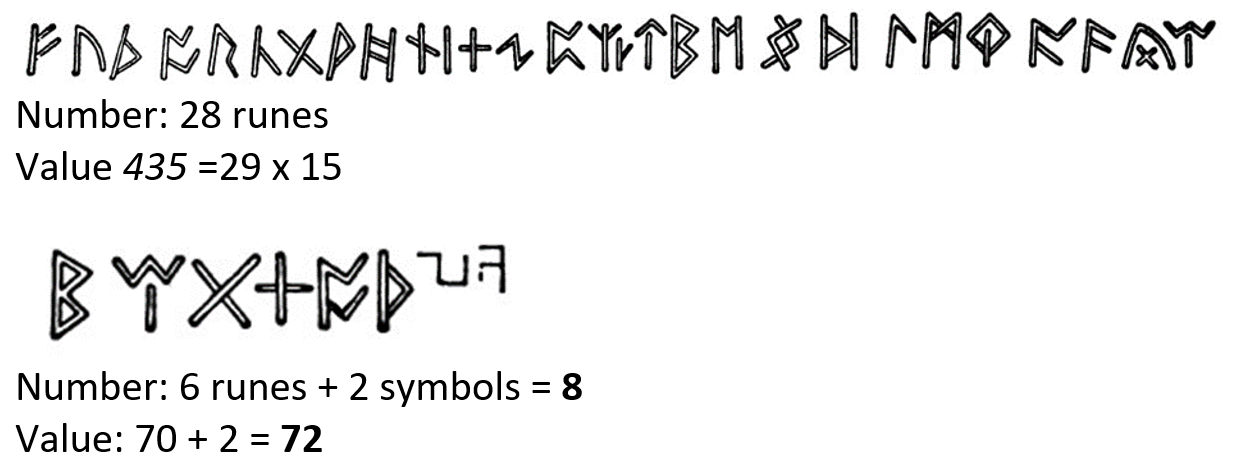|

With kind permission of the National Museum, Denmark
Mjölnir: The Købelev Runic Thor's Hammer (Lolland)
"A small hammer dating to the 10th century was found recently on the Danish Island of Lolland. Over 1000 of these amulets have been found across Northern Europe but the pendant from Lolland is the only one with a runic inscription." (PASTHORIZONS, The Hammer of Thor [Sunday, June 29, 2014].
Blog History explains: The finder, metal detectorist Torben Christjansen, reported the find as treasure trove to the local Museum Lolland-Falster where curators dated it to the 10th century. The amulet was cast in bronze and has traces of the silver or tin plating and gold plating that once adorned it. One side of the hammer’s head is decorated with interlacing pattern, the other side with a runic inscription seven characters long. This is the first Thor’s hammer amulet ever found inscribed with runes.
Because the runes were so small — three to seven millimetres high — and the surface corroded from the centuries it spent in the ground, the Museum Lolland-Falster curators sent the amulet to the National Museum of Denmark for their experts to decipher. Examining it under a microscope, museum runologist Lisbeth Imer was able to translate the inscription and it resolves the hammer question in the bluntest terms possible: the runes read “Hmar is x,” or in modern Danish “Hammer is” (the x isn’t a letter but a delimiter between two words). Translated into English the inscription simply says “This is a hammer.”
There are two mistakes in the runes. The author left out the first a in “hammer” and flipped the S-rune backwards à la Toys-R-Us. These could have been errors of literacy or a function of the tiny space the writer had to inscribe. Even if his or her spelling was spotty, the rune carver would have derived status and prestige from being literate in a society that prized writing."
As to the runic inscription PASTHORIZONS - probably L. Imer's text - continues: “However, the person who inscribed these runes was not a skilled writer, as the proper spelling should have been Hamar . Also the S-rune was reversed.”
We might add a comment on the weird syntax here. How about: DIS IS HAMAR instead?
Looking at it more closely the runic inscription
H M A  x I S seems to be very well planned and calculated. It was meant to cite the magic power of the object; i.e. Thor’s hammer Mjölnir, which is associated with lightening. x I S seems to be very well planned and calculated. It was meant to cite the magic power of the object; i.e. Thor’s hammer Mjölnir, which is associated with lightening.
By inserting a meaningless symbol (x) and omitting the first A the  becomes the central rune framed by H and S, which is even more evident as the rune becomes the central rune framed by H and S, which is even more evident as the rune  is reversed, a shape, by the way, which is not unique at all.1
If we now figure the value of the 6 runes according to their rank in the younger fuþark (7+14+4+5+x+ 9+11) we get the runic value 50 which is the tenfold of 5. According to its position in the runic row 5 stands for the rune is reversed, a shape, by the way, which is not unique at all.1
If we now figure the value of the 6 runes according to their rank in the younger fuþark (7+14+4+5+x+ 9+11) we get the runic value 50 which is the tenfold of 5. According to its position in the runic row 5 stands for the rune  , here – extra huge – in central position. Thus sequence of runes hinges on the rune-name *raiðo 'riding' and the OE derivative rad, in the expression þunorrad 'Þunor's riding, clap of thunder', referring to Thor’s armed chariot, which on its way through the skies produces this frightening growl. How appropriate for Mjölnir, which produces the flashing thunderbolt!2 , here – extra huge – in central position. Thus sequence of runes hinges on the rune-name *raiðo 'riding' and the OE derivative rad, in the expression þunorrad 'Þunor's riding, clap of thunder', referring to Thor’s armed chariot, which on its way through the skies produces this frightening growl. How appropriate for Mjölnir, which produces the flashing thunderbolt!2
Having a look at the individual runes they appear to be quite appropriate for an item that is meant to help at war. Certainly, the warrior wants to win his fight, but when his time is up he needs to die in battle if he desires afterlife in Valhalla. Dying in bed would send him to Hel, the realm of shades.
The first rune H (ON hagall, hail) stands for danger of life, here imminent death, while the last rune S (sól, sun) may promise life for the victim, slain by the help of Thor`s hammer, summoned by the rune  (reidh, ride, here: noise of Thor’s cart). (reidh, ride, here: noise of Thor’s cart).
We could extend this view on the remaining runes: [M] (madhr, man) stands for the human being, [A] (ár, year, harvest) and [I] (íss, ice), which is synonymous with death.
Risking speculation we may interpret: Peril to life [H] for a man [M] as his “time is ripe” [A]. Thor’s thunderbolt [R] strikes (or helps to strike) him dead in battle [ I ]. This kind of death procures (after)life [S] in Valhalla among the Einherjer.3 If this reading were unique, it would be quite risky, but as shown below the Franks Casket helps with a parallel practice.
We are not quite sure though whether such a spell conjures the "way of Wyrd" of the amulet's owner or that of his enemy.
At this point we may reflect on the number of symbols. There are 6 runes producing the value 50 (10 x 5). But altogether we have 7 characters, a number which corresponds quite appropriately with the “perilous” rune [H]. So the amount of characters (7) signals mortal danger and their value (50) shows how it is brought about or, maybe, how it is averted.
There are interesting parallels to this runic practice on the Franks Casket. Here too, the rune  – the initial of
Romulus and Remus – stands for the ride to war. The Roman twins are the sons of Mars, the Roman God of war. On the picture they are accompanied by two wolves, probably an allusion to Geri and Freki, the companions of Woden, the Germanic counterpart of Mars. – the initial of
Romulus and Remus – stands for the ride to war. The Roman twins are the sons of Mars, the Roman God of war. On the picture they are accompanied by two wolves, probably an allusion to Geri and Freki, the companions of Woden, the Germanic counterpart of Mars.
Another scene depicts the death of a warrior and resurrection into Valhalla. Here Herh-os (a deity) brings end about, A and E direct fate and S eventually procures entry into Valhalla.
The text (partially encoded in order not to become effective before the time has come) is composed in stave rhyme, the alliterating runes procure the destiny desired.
| |
herh os sitæþ on hærmberge
agl(ac) drigiþ swa hir i erta e gisgraf
særden sorgæ and sefa tornæ
|
|
 
 
  
|
As the wording of the sequence H I R / I / E R T A is not really certain we might even read "IERTA".
In this case we arrive at the sequence H A I S which is even closer to H M A R I S on the amulet.
And there is still another parallel between Thor’s hammer and this panel of the Anglo-Saxon hoard box, the valknutr, Woden(Odin)’s knot of death, which appears twice on this panel below the horse that will carry the dead hero to Valhalla. Two such knots of death, hallmarking Valhalla, are depicted on the lid, and a third one shows behind the third of the Magi, the one who brings myrrh, the symbol of death as it used for embalming the dead body. These 5 knots have their parallel on the shaft of the hammer, one clearly visible below the inscription, the second one, heavily corroded, on the backside beneath an interlace pattern, which is most likely no mere decoration.
To sum it up: The H-rune  – initial of a mysterious Herh-os – introduces the adverse fate which is averted by the apotropaic runes for A (encoded) and E (encoded) and ends with the S-rune – initial of a mysterious Herh-os – introduces the adverse fate which is averted by the apotropaic runes for A (encoded) and E (encoded) and ends with the S-rune  in alliteration as a hint at afterlife in Valhalla. The numeric value of the runes in alliteration, by the way, is 110, a value repeated in other magic formulas around the chest. in alliteration as a hint at afterlife in Valhalla. The numeric value of the runes in alliteration, by the way, is 110, a value repeated in other magic formulas around the chest.
Coincidence or not Helgi, the warrior, dies in the arms of Sigrun, his Valkyrie.
(Helgakviða Hundingsbana I and Helgakviða Hundingsbana II, in the Poetic Edda)
                                                                            

The Durham Pendant
Description, adopted from Portable Antiquities Scheme Website, run by the British Museum and the National Museum Wales:
A complete gold Latin cross pendant, with runic inscription, dating to the early medieval period (c.AD700-900).
PENDANT
Unique ID: DUR-B62F57 Object type certainty: Certain
Workflow status: Awaiting validation
Description: A complete gold Latin cross pendant, with runic inscription, dating to the early medieval period (c.AD700-900). The solid gold cross is of simple form: the long arm is uppermost, with a crude ‘repair’ piercing at the apex; the slight concavity along the upper edge is indicative of a previous worn piercing or attachment, and the terminal has been diagonally filed to ‘finish’ this arm following the repair. Almost the entire length of the arm is filled with an inscription comprising six runes; two parallel scratches to the right of the piercing appear to be an attempt to reinstate to rune removed by the repair. The horizontal arms and basal section or ‘foot’ (perhaps more correctly the vertical beam below/above the crossbeam, depending on view) are each decorated with a single crudely incised equal armed cross (noting that cross on the left arm is somewhat less than ‘equal armed’). The foot protrudes slightly more than the horizontal arms, and is notably bulbous in appearance; all lower terminal edges are rounded. The reverse of the cross is undecorated.
Inscription: ᛖᚫᛞᚱᚢᚠ - ead͡ruf
The general appearance of the cross is quite worn, demonstrated by the loss of the possible attachment and subsequent repair, and by pitting and scratches reverse.
Our view: Durham and Købelev compared
The inscription on the Durham pendant reads ᛖᚫᛞᚱᚢᚠ (E A - DR - U F).
The R rune  (OE. rad, NE. ride - value 5) was placed in the middle by merging it with the preceding U (OE. rad, NE. ride - value 5) was placed in the middle by merging it with the preceding U  to form a "binder rune" (ligature). Significantly, we now have 5 runes (instead of 6) here, giving the value 505. Since 5 represents the rune to form a "binder rune" (ligature). Significantly, we now have 5 runes (instead of 6) here, giving the value 505. Since 5 represents the rune  (protection oÞlæ unneg), the tenfold is a magical enhancement of the spell.6 (protection oÞlæ unneg), the tenfold is a magical enhancement of the spell.6
The same method is used on the Thorshammer of Købelev (see above), where the carver changed the word order from "Þis is hamar" to "hmaR\is", dropping one word and omitting one letter plus adding one meaningles  -like symbol on the way. -like symbol on the way.
Thus the  was moved from the end into the center here right between 3 runes to either side. was moved from the end into the center here right between 3 runes to either side.
And the Thorshammer likewise produces the value 50.
The inscription on the Durham pendant may be interpreted like this: The runes A ( oak) and E ( oak) and E ( horse) - left of the bindrune DR horse) - left of the bindrune DR   - stand for defence; right of it we have U ( - stand for defence; right of it we have U ( Ur, strength) and F ( Ur, strength) and F ( wealth). wealth).
The runes on the Købelev Thors-hammer are dictated by the words hamar is and thus should not be interpreted this way.
The Durham cross has been subsequently pierced at its base, - most likely for a ribbon with which to hang it around one's neck as a protective charm. This cross-shaped pendant with additional carved cross signs was worn upside down, like a Thors-hammer.
This talisman could have belonged to a merchant driver who tried to protect himself in this way against robbery and murder.
The Thames Seax, BeagnoÞ and his mysterious hall mark
As to the Thames Seax we cite Wikipedia: “The Seax of Beagnoþ (also known as the Thames scramasax) is a 10th-century Anglo-Saxon seax (single-edged knife). It was found in the inland estuary of the Thames in 1857, and is now at the British Museum in London. It is a prestige weapon, decorated with elaborate patterns of inlaid copper, brass and silver wire. On one side of the blade is the only known complete inscription of the twenty-eight letter Anglo-Saxon runic alphabet [i.e. fuþorc], as well as the name "Beagnoþ" in runic letters. It is thought that the fuþorc had a magical function, and that the name Beagnoþ is that of either the owner of the weapon or the smith who forged it. Although many Anglo-Saxon and Viking swords and knives have inscriptions in the Latin alphabet on their blades, or have runic inscriptions on the hilt or scabbard, the Seax of Beagnoþ is one of only a handful of finds with a runic inscription on its blade.”

The 28 runes produce a value that makes sense: 435. It can be interpreted as 29 x 15. The rune  is the 15th letter in Fuþorc as well as in Fuþark and it stands for the Valkyrie. This way her assistance as helper in battle is called upon. is the 15th letter in Fuþorc as well as in Fuþark and it stands for the Valkyrie. This way her assistance as helper in battle is called upon.
This invocation is strengthened by the name Beagnoþ numbering 6 runes and producing the rune value 70. The 2 rune-like characters behind it then result in the significant rune number 8 (3 x 2) and the not less significant rune value 72 (9 x 8). In this way, the runic row and the name - that is, the Valkyrie and the rune magician - protect the bearer of the weapon in battle.
_
_______________________________________________________________________________________________________________
1 Gœrlev-Fuþark etc. Düwel, Runenkunde (2001), 88 ff.
2 An interesting word found in Old English that could have come from a belief in Thunor is Thunorrad, which means thunder riding or Thunor riding. In Old Norse belief Thunor's Scandinavian counterpart, Thor, is said to ride across the sky in a goat drawn chariot, so it's possible that when the Heathen Anglo-Saxons heard the sound of thunder in the sky, they may well have believed it was Thunor riding across the sky like Thor, and called such a belief Thunorrad or thunder riding.
3 Wikipedia: In Norse mythology, the einherjar (Old Norse "single (or once) fighters") are those that have died in battle and are brought to Valhalla by Valkyries.
4 That the piece may be an import is suggested by the report (British Museum): "This inscribed object is a small gold cross of very simple shape, unusual for Anglo-Saxon England but not unparalleled."
5 The 10-fold always causes potentiating effect of the magic number, just as the basic value may stand for the actual amount. Thus 430 may stand for 430.000 (see Lid: Einherjer)
6 The runic name *raiðo, ride, describes the 'exit' (to the fight) and with the expression þunorrad "Thor's exit".
7 Arntz, Handbuch der Runenkunde (1944), p. 278: "The sun-horse originally belongs to the sky-god (  ); but in more recent times - and certainly already in the 6th century - Sleipnir and Odin form a solid unit ( ); but in more recent times - and certainly already in the 6th century - Sleipnir and Odin form a solid unit (  )." Thus originally the runes )." Thus originally the runes
 and and  would have denoted the sun horse of the sky god Tir (English Tiw), for which the runes a and e were later set to cite the horse of the god of the dead. Concerning horse and rider on bracteates Arntz refers to Marstrander, NTS. 1, p. 76f. would have denoted the sun horse of the sky god Tir (English Tiw), for which the runes a and e were later set to cite the horse of the god of the dead. Concerning horse and rider on bracteates Arntz refers to Marstrander, NTS. 1, p. 76f.
|







